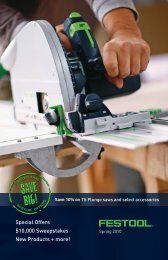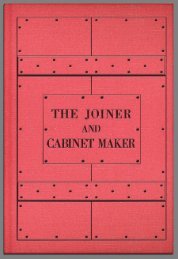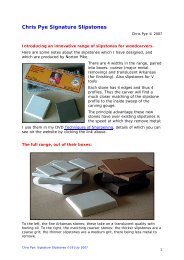WORK: Vol.1-No.51 - Tools for Working Wood
WORK: Vol.1-No.51 - Tools for Working Wood
WORK: Vol.1-No.51 - Tools for Working Wood
You also want an ePaper? Increase the reach of your titles
YUMPU automatically turns print PDFs into web optimized ePapers that Google loves.
•••Horv ro .AfAKE A PIANO.._·•• •••Jat the back.•••Fig. ~shows the foot-shelf which rests on•the bottom framewot·k, beyond which itprojects some i of an inch. This foot-shelf• 1S lettered A in the section Fig. 3 ; and theframe on which it rests is indieated bydotted lines in Fig. 2. It is of ~·in. board,and its edges are moulded, as shown, exceptThis foot-shelf will <strong>for</strong>m nobad place <strong>for</strong> the display of artistic pottery-three vases or other articles, a taller onein the centre and lower ones at the sides,, will show well upon it.· Fig. 3 is a. section through the centre ofthe table. Iu it may be seen how thebottom of the locker, marked B, is supportedby the framework of tile upper part. Butthe arrangements of the locker a re morecompletely illustrated in Fig. 4, where theymay be seen as from above, be<strong>for</strong>e the topof the table has been fixed in place. Thislocker is divided by partitions into compartmentsof convenient size <strong>for</strong> pa.pcrs orother small matters. The largest cornpart·ment is 11 in. long by 7 in. broad, and thewhole locker is 5 in. deep. The more· important partitions-those from back to· front- are of t-in. board, and about 41 in.high; the subdivisions are of thinner stuff,and <strong>for</strong> them a height of some 3 in. is sutticient,as shown at c, Fig. 3.At D, Fig. 4, is shown a strip of woodnttaehed by a screw to one of the partitions.It is <strong>for</strong> the support of that part of the tabletopwhich <strong>for</strong>ms the lid of the locker, whenit may be desired to prop it open. Tnprevent all danger of slipping, it may notbe amiss to notch like ·a rack that part ofthe lid which rests upon it.In this same dia.gram (Fig. 4)· i-s to beseen something of the relative relief of thedifferent pieces of applied ornament. Thesepieces are in a general way simply glued tothe surface. Among·the furniture makersof the seventeentl'l century it was rarelyusual to trust the effect of their workentirely to appliq11e decoration. They morefrequently used it in combination withcarving or inlayin~, or both. ApJ'liquework, however, surv1ved carving, <strong>for</strong> we findabundant, and some of the hest, examplesof it dating from as late as tllc earlier partof last century, and from a period whencarving had passed out of fashion. Theexample be<strong>for</strong>e us is, as regards ornament,auythino- but an elaborate one. The twocarbuncfes 0n each side are, of course, turnedin one and sawn through. The lozengebetween them is sawn out and worked byhand . . The fluted pieces at each end arealso readily worked by hand ; in re~toringthe original of the drawings, the writer hadto supply one of these pieces, and founuit could be quickly worked with the gouge.In Fig. 5 we have the top, ~ of an in.in thickness, and moulded at all its edgesexcept the back one. Access to the lockernecessitates that it should be in two pieces,of which that at the back-the fixed one-is4 in. wide. If, however, any person makingsuch a table should object to such a divisionin the lid, an alternative is open to him·be may omit the locker, and instead have adrawer on the front side. More than onedrawer he could not well have ; and thiswould, of course, involve some loss of space,and make, on the whole, a less useful articleof furniture than the original, which willserve many of the purposes of a bureau.Indeed, to the writer, the locker appears. ao characteristic a feature of this table, thatli_. would not willingly 'sacrifice it. Aningenious combination of purposes, analogous.tb that .shown in this table, is not unfrequentm earlysevent'eenth~centuryfurniture.The writer has met with j oint-stools ofthe .Jacobean period, the tops of which,by removing n. secret fastening, could bemade t o open and disclose unexpectedreceptacles within. Such receptacles were,no doubt, useful in days when portableproperty was even less secure than in ourown. Anothet· instance with which h e hasme't was an arm-chair, of much the samedate, the back of which, when turned downon the arms, made a circular table some3 ft. 6 in. in diameter. A rhair-table likethis, or one on somewhat similar line~. wouldnot make an unattractive subject to amateurcarpenters, and possibly a corner may atsome time or other be found in WonK <strong>for</strong>dmwings of one.The original of our Jacobean side-table is,like most of the furniture of the age inwhich it wnR made, <strong>for</strong>med wholly of oak;and oak will be tbe best material <strong>for</strong> anyone who attempts an exact reproduction ,;rit. A pretty table, however, 9.11 much thesame geneml lines, but more hghtly made,might be constructed in J?ine, and ebonised-the amateur joiner will probably preferto work in the latter less costly and moreeasily wrought wood.A suggestion may be A.dded <strong>for</strong> the benefitof any one making such a table as this inoak and wishing it to harmonise with otheroak furniture which •. is carved. He maygain that end with little labour by runninga carved enrichment-some Jacobean varietyof the'' egg-and-dart "-along the mouldededges of the table-top and foot-shelf.HOW T,? MAll! A PIA.I O.BY- ........ ..._NlL DESPERANDU.M."llEOULATINo, T uNINo, AND To:NIXo-Co•·CLUSION.TAKE out the keys and place them onben.ch ; t~en take a thin piece of wood 8 {!:~an mch wide, and wrap round it a. piece offine glass-pal-!er, and .rub over the wood of~he keys, behm~ the Ivory or sharp, cleanlllg'one. at a time ; then brush the dust offthem ; If you see any on the key bottom>~re!11ov~ it. ~etween t~e balance and fro~trails .fit a P.Iece of tbm wood to preventt~e hght bemg seen through the spacesol the keys. Now, whera the ends of theslHl.rps w~re cut oft', black with ink a.boue.an lltch wtde; also black the lower part ofthe sharp from this line. While the ke]sare out, tak_e off your damper rail carefully,and by movmg each hammer t o the strin~see that each hammer !itt·ikes it fair· J!'the shauk has cast to one side or the othera~ shanks do sometimes, you can alter itwarrni11g an old file, or flat piece of steeand bold it to the side you wish to benover. Now you can see that the bridlesor tapes of your action are properly adjusted; put one finger under the lever andraise lightly, and there ought to be nof an inch play between the top of thefiy and the hammer butt; if there is not,you can make it so by bending the bridlestay either backwards or <strong>for</strong>wards. Nowtake the action out and put the keys backin their place, and take each key separately,and see that it works free; if not.ease it with your file, but do not make itloose ; if you find it a trifle loose, you can ta.J>it gently with a hammer over the hole; thiswill tighten it. Having done this, put theaction in its place and see if there are anypilot screws which need turning up, as in theii nishing. Now look over the keys and seethat they are straight to your straight-edge,then tap on the keys 'vith your straight-edge,and those that are high will move ; take ashaving off. these and make the low one&level with 'tissue paper. The spaces of ~e ·keys must now be adjusted, then the actionmust be regulated or set off. ~ wql nowdescribe what is meant by this : .if thereader will kindly look at the act1on, bewill find that through the fly of the hopperthere is a wire with a button on the end; 88the key is depressed, this button resta onthe slide rail, this bein~ on the bevel 7as it rises the fly is pus.11ed <strong>for</strong>ward fromunder the' hammer, allowing the ~amm!ITto fall into- check. This is accomplished mthe following manner.As tbe hammermoves twards the string, the check fochllowkit, and when t~e h.ammer .fa ll~ , the ecis there to recetve 1t, holdm? 1t firmly hithe check arm. Make a hooK, so that yocan turn the wire that has the ~pemenJbutton on. Now sit down at t~ e ptan~:.ei,£commence with the first note m the h the,press the key gently down, and w~utto:hammer ; if you turn the escapemen erto the left you will find t.hat the hafmm 't·u bump' tl.=inst the strmg ; thel'e 0 ~ 1w1 t-- • • ciill d blocking.damps the tone, or, as 1t 18 he 1 • ht, andNow turn the escapement to t e ngyou will find that the hammer escak f~=m thethe string i the cp!!Ck a~lows thfto fall the requ1s1te dlStance romup tostring. Allow the hamm~r to a!d -allowthe string within :h of a.n m~ the ·it to fall, after 1t has struc theabout f of an inch.Reg~!istedisi~to catch the hammer at ..bending it <strong>for</strong>wat:d or ba;ek1Vai:'CLt'Mkey has ts,.ken the hammer to . ••The Work Magazine Reprint Project (-) 2012 tools<strong>for</strong>workingwood.com• •













